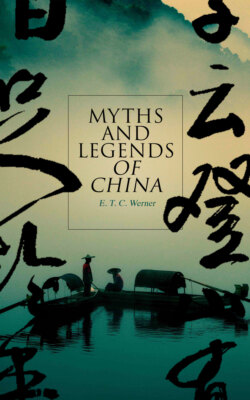Читать книгу Myths and Legends of China - E. T. C. Werner - Страница 27
На сайте Литреса книга снята с продажи.
Funeral Rites
ОглавлениеNot understanding the real nature of death, the Chinese believed it was merely a state of suspended animation, in which the soul had failed to return to the body, though it might yet do so, even after long intervals. Consequently they delayed burial, and fed the corpse, and went on to the house-tops and called aloud to the spirit to return. When at length they were convinced that the absent spirit could not be induced to re-enter the body, they placed the latter in a coffin and buried it—providing it, however, with all that it had found necessary in this life (food, clothing, wives, servants, etc.), which it would require also in the next (in their view rather a continuation of the present existence than the beginning of another)—and, having inducted or persuaded the spirit to enter the 'soul-tablet' which accompanied the funeral procession (which took place the moment the tablet was 'dotted,' i.e. when the character wang, 'prince,' was changed into chu, 'lord'), carried it back home again, set it up in a shrine in the main hall, and fell down and worshipped it. Thus was the spirit propitiated, and as long as occasional offerings were not overlooked the power for evil possessed by it would not be exerted against the surviving inmates of the house, whom it had so thoughtlessly deserted.
The latter mourned by screaming, wailing, stamping their feet, and beating their breasts, renouncing (in the earliest times) even their clothes, dwelling, and belongings to the dead, removing to mourning-sheds of clay, fasting, or eating only rice gruel, sleeping on straw with a clod for a pillow, and speaking only on subjects of death and burial. Office and public duties were resigned, and marriage, music, and separation from the clan prohibited.
During the lapse of the long ages of monarchical rule funeral rites became more elaborate and magnificent, but, though less rigid and ceremonious since the institution of the Republic, they have retained their essential character down to the present day.
Funeral ceremonial was more exacting than that connected with most other observances, including those of marriage. Invitations or notifications were sent to friends, and after receipt of these fu, on the various days appointed therein, the guest was obliged to send presents, such as money, paper horses, slaves, etc., and go and join in the lamentations of the hired mourners and attend at the prayers recited by the priests. Funeral etiquette could not be pu'd, i.e. made good, if overlooked or neglected at the right time, as it could in the case of the marriage ceremonial.
Instead of symmetrical public graveyards, as in the West, the Chinese cemeteries belong to the family or clan of the deceased, and are generally beautiful and peaceful places planted with trees and surrounded by artistic walls enclosing the grave-mounds and monumental tablets. The cemeteries themselves are the metonyms of the villages, and the graves of the houses. In the north especially the grave is very often surmounted by a huge marble tortoise bearing the inscribed tablet, or what we call the gravestone, on its back. The tombs of the last two lines of emperors, the Ming and the Manchu, are magnificent structures, spread over enormous areas, and always artistically situated on hillsides facing natural or artificial lakes or seas. Contrary to the practice in Egypt, with the two exceptions above mentioned the conquering dynasties have always destroyed the tombs of their predecessors. But for this savage vandalism, China would probably possess the most magnificent assembly of imperial tombs in the world's records.
